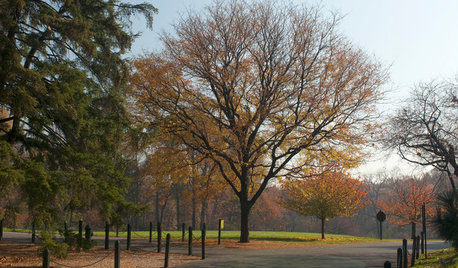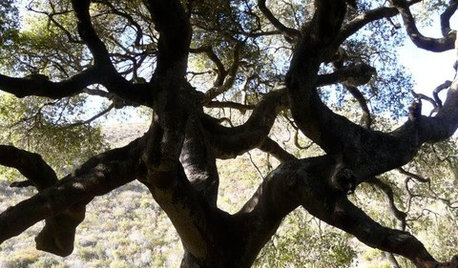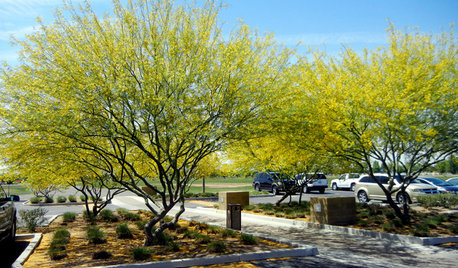Tree with huge thorns
catherinet
18 years ago
Featured Answer
Sort by:Oldest
Comments (15)
viburnumvalley
18 years agoRelated Discussions
Thorny tree and another mystery tree
Comments (5)Thank you for figuring out my mystery! I looked up the hawthorn online and feel lucky to have one! I have a lot of deer mesh so maybe I will protect this one when the weather turns. I was walking through the woods behind my house yesterday and I notice quite a few more hawthorns. They are much larger in the woods. I'm looking forward to seeing it bloom. Their presence makes sense because this land used to be a grazing pasture for cattle. Thanks again!...See Moreunknown bush with HUGE thorns!!
Comments (3)It is a landscape ornamental, although not a very common one around here, so you should be able to buy it. It says it's used as a rootstock for citrus trees, too. A fast Google search came up with 'Tripple Brook Farms', and I'm sure there are other places on line or by mail if you can't find it locally. WW Here is a link that might be useful: Poncirus (and check out the dwarf version too)...See MoreWild Orange?
Comments (5)It's probably poncirus trifoliata if it's like the ones I saw in East Tennessee in the 70's. Mostly thorns, relatively few leaves that come in threes, perfumed sort of fuzzy fruit. Lovely thing. Will grow as far north as Philly or even further if sheltered. Here's a link: http://www.eattheweeds.com/hardy-orange/...See Morehuge huge bee hive in backyard tree
Comments (4)Dena...I am in Spring. Had them in my wall. Was terrified of them and the price to remove. I thought it would be thousands of dollars to remove in a wall.Thank G-d they just set up shop in that wall and that I noticed them. I called : http://www.bayoucitybees.com/ The nice man came out, and it was like $250-275. Amazing job. He was such a noce young man and talked me thru it! Here is a link that might be useful: Bayou City Bees...See Morecatherinet
18 years agoSoeur
18 years agocatherinet
18 years agocatherinet
18 years agoterryr
18 years agocatherinet
18 years agojohn_mo
18 years agocatherinet
18 years agojillmcm
18 years agoclarkp8_yahoo_com
15 years agobob64
15 years agopat8
15 years agogreenhaven
15 years ago
Related Stories

GARDENING AND LANDSCAPINGUrns Hold Huge Potential for Garden Decorating
Classic urns have uses far beyond holding olive oil and flowers. See how to use them as unexpected sculpture and more in the landscape
Full Story
GARDENING GUIDESGreat Design Plant: Honey Locust Tree
No, it doesn't actually produce honey. But its dappled light and tolerant nature are treats in city and country settings alike
Full Story
GARDENING AND LANDSCAPINGArbor Day Applause: Iconic Los Angeles Trees
Step aside, palm trees. California's native trees offer landscapes a huge variety of styles, personas and foliage
Full Story
FALL GARDENING6 Trees You'll Fall For
Don’t put down that spade! Autumn is the perfect time for planting these trees
Full Story
FALL GARDENING11 Trees for Brilliant Fall Color
Give your landscape the quintessential look of autumn with the red, orange and yellow leaves of these standouts
Full Story
GARDENING GUIDESGreat Design Tree: Australian Tea Tree
A living sculpture with an unmistakable appearance, this coastal native creates an intriguing landscape scene
Full Story
TREESGreat Design Plant: Desert Museum Palo Verde Offers a Colorful Canopy
Rising above others with its long bloom time, artful vase shape and lack of thorns, this tree is great for casting filtered shade
Full Story
EDIBLE GARDENSWhy Grow Quince? For Beauty, Fragrance and Old-Time Flavor
Delightfully perfumed fruit and lovely spring blossoms make this apple and pear cousin worth a spot in the garden
Full Story
TREESGreat Design Plant: Cascalote Tree for Sunny Southwestern Style
Enjoy lovely yellow flower spikes in fall and winter with this drought-resistant tree
Full Story
EDIBLE GARDENSHow to Grow 10 Favorite Fruit Trees at Home
Plant a mini orchard in fall, winter or early spring to enjoy fresh-off-the-tree fruit the following year
Full Story


paalexan